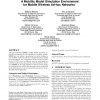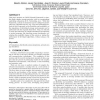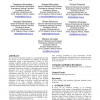SIMUTOOLS
2008
13 years 11 months ago
2008
This work describes mechanisms for simulating opportunistic and delay-tolerant networks in the OMNeT++ discrete event simulator. The mechanisms allow for simulating open systems o...
SIMUTOOLS
2008
13 years 11 months ago
2008
Optical Burst Switching (OBS) has been proposed as a costeffective paradigm for supporting, with adequate flexibility, the increasingly high transmission capacity required by the ...
SIMUTOOLS
2008
13 years 11 months ago
2008
A collaboration between simulationists and scientists working on fire spread and ecology led to the design of a 3D visualization tool. This tool is a post-processor which can be l...
SIMUTOOLS
2008
13 years 11 months ago
2008
We sketch the fundamental properties and features of Snoopy, a tool to model and execute (animate, simulate) hierarchical graph-based system descriptions. The tool comes along wit...
SIMUTOOLS
2008
13 years 11 months ago
2008
SIMUTOOLS
2008
13 years 11 months ago
2008
In this paper, we present the design and the implementation of a novel scheme for the multicast transmission of data over Universal Mobile Telecommunications System (UMTS) network...
SIMUTOOLS
2008
13 years 11 months ago
2008
This paper presents an OMNeT-based Framework to simulate large complex storage networks, with its corresponding underlying subsystems (I/O, Networking, etc.). With this Framework,...
SIMUTOOLS
2008
13 years 11 months ago
2008
This paper presents an approach to simulate complex hierarchical process chains resulting from large logistics networks in OMNeT++, a discrete event simulation environment designe...
SIMUTOOLS
2008
13 years 11 months ago
2008
In silico (on the computer) oncology is a multi-disciplinary field that focuses on the examination and modeling of biological mechanisms related to the phenomenon of cancer. In si...
SIMUTOOLS
2008
13 years 11 months ago
2008
Wireless communication has attracted considerable interest in the research community, and many wireless networks are evaluated using discrete event simulators like OMNeT++. Althou...



